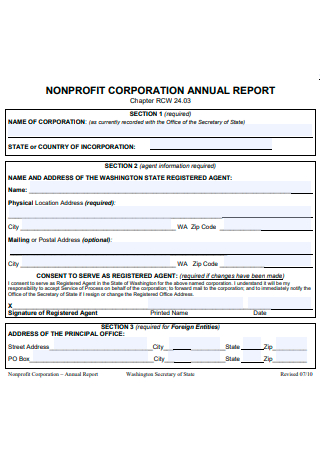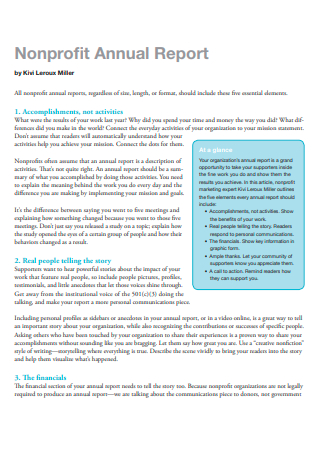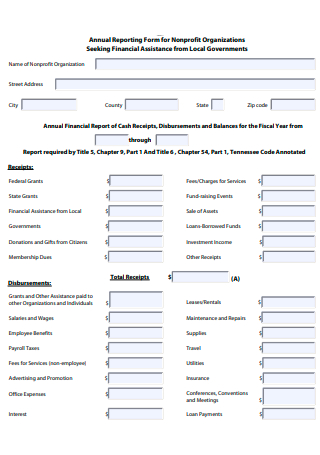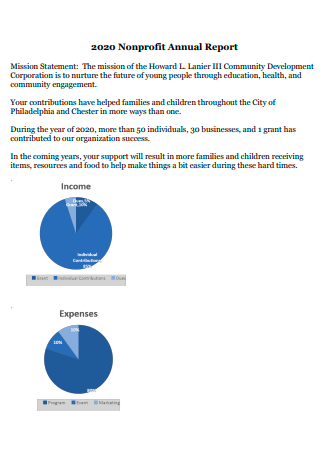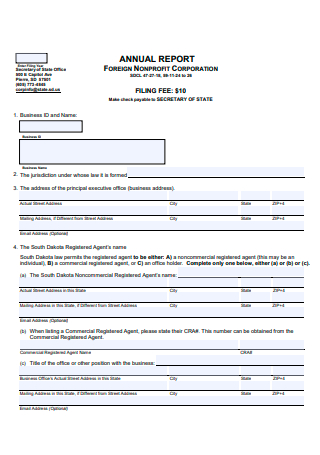5+ Sample Nonprofit Annual Report
FREE Nonprofit Annual Report s to Download
5+ Sample Nonprofit Annual Report
What Is a Nonprofit Annual Report?
What’s Inside a Nonprofit Annual Report?
Advantages of Being a Nonprofit Organization
Steps in Writing a Nonprofit Annual Report
FAQs
What’s the most critical part of the nonprofit annual report?
What and how do organizations qualify as nonprofit?
Can annual reports be done in postcard form?
What Is a Nonprofit Annual Report?
Before we define the report document, first of all, what is a nonprofit organization and what does it entail? In plain terms, a nonprofit organization is one that is not motivated by profit. To elaborate, a nonprofit organization is a tax-exempt company that promotes a social purpose and delivers a public benefit. Nonprofit organizations are sometimes referred to as trusts, cooperatives, advocacy, charitable, environmental, and religious organizations. A nonprofit organization nearly always employs volunteers and relies on their devotion and conviction in their mission because it is difficult for them to compete with private-sector salaries. Nonprofits, however, may have challenges to face, such as funding challenges because they mainly rely on outside sources like donations.
Nonprofit organizations rely on donations or grants to perform their goals, and whatever it is that they’ve accomplished must be reported on a document called a nonprofit annual report. It is a business document that is created and distributed by nonprofit organizations each fiscal year. It is intended to showcase the organization’s main successes, motivate readers about the mission of the organization, establish trust, and thank contributors for their support. Despite the fact that annual reports are not required by law, most nonprofit leaders appreciate the significance they can provide, as this document can help illustrate a non-profit organization’s achievements to current and future financial backers, develop new alliances, and acknowledge important figures to their cause. Even though it is not legally needed, when nonprofit organizations opt to construct one, they must take it seriously because there is so much at stake when done half-heartedly, such as the achievement of the organization’s goals.
What’s Inside a Nonprofit Annual Report?
Listed and discussed below are the key components that need to be included when creating a nonprofit annual report document:
Advantages of Being a Nonprofit Organization
Listed and discussed below are some of the advantages that come with being a nonprofit organization:
Steps in Writing a Nonprofit Annual Report
The benefits of having a well-written annual report for your nonprofit organization will always vary depending on the needs of the group. However, for the group to enjoy its benefits, this document still needs to be prepared well. With that being said, here are the steps needed to properly write a nonprofit annual report:
1. Write the Introductory Part
The first step to writing a nonprofit annual report is to complete the introductory part. There are many parts here, depending on the nonprofit organization. The introductory section of the nonprofit annual report can establish the subject, summarize the information, and give the report a personal touch. It may also include letters or statements from the nonprofit organization’s executive director and chair. When developing this section of the report, keep in mind that it should be brief, have a professional but warm and pleasant tone, identify setbacks and obstacles as well as successes, and present an optimistic, upbeat attitude while being honest.
2. Showcase the Main Stories
The next step that is to be done after creating the introductory part of the nonprofit annual report is to showcase the main stories that the nonprofit organization has to tell that cover the past 12-month period. It is critical in this section of the nonprofit annual report to demonstrate the organization’s mission in action by telling a story about each big success. Keep in mind when writing this section of the annual report that it can be condensed and the details adjusted to preserve privacy, but it must still be true to its essence. It should also focus on a central individual, telling the tale in the person’s own words as much as feasible, and illustrate a change as a result of the nonprofit organization’s activity and the donors’ donations.
3. Detail the Financial Information
After showcasing the main stories concerning the organization’s activities within a 12-month period, it’s time to proceed to the financial data in this step. In this step, it is critical to provide the nonprofit organization’s financial facts in a way that is understandable to your audience. To do so, it must clearly explain where the income originates from and how it is spent. It is OK to shorten the format and present an overview. To help readers see the broad picture and comprehend financial patterns, incorporate visuals such as pie charts, bar graphs, or visualizations in addition to the data offered in standard financial statements. In this stage of preparing the annual report, a brief narrative synopsis is also essential. Explain in simple words the significance of all the statistics provided.
4. Acknowledge the Contributors
In this last step of writing the nonprofit annual report, keep in mind that it’s also important to recognize the people who made it possible. Many organizations prefer to display the names of the donors as well as the amounts of their contributions. This is a method to say thanks while also demonstrating to contributors that they are part of a vast network of supporters. Still, it’s a list of names, so it’ll be skimmed. People search for their own names but seldom read through the full list. To get the most out of the pages, intersperse phrases and photographs. Following that, provide the report’s readers a next step with a powerful call to action that is repeated throughout the report. This might be as basic as asking for a donation to the organization’s cause.
FAQs
What’s the most critical part of the nonprofit annual report?
The explanation of accomplishments is the most significant component of a nonprofit annual report. The readers obviously want to know what the organization accomplished, but they also want to know the reasons why the organization did it. Readers are also interested in the outcomes, including why the nonprofit used its time and money in the manner that it did and what difference it created.
What and how do organizations qualify as nonprofit?
Only organizations that advance religious, scientific, philanthropic, educational, cultural, public safety, or cruelty-prevention purposes or goals are granted nonprofit status and tax-exempt status. Furthermore, the organization must assist the public in some way, whether by providing commodities, services, or a mix of the two. They must also make financial and operational information available to the public so that contributors may learn how and how well their gifts have been used.
Can annual reports be done in postcard form?
Yes, they can. Postcards are an excellent alternative if maximum readability is desired. Supporters may comprehend how the charity organization performed last year by using well-designed infographics, photos, and data. However, because there is only so much that can fit into a tiny space, this works best for short-form annual reports. If comprehensive narratives are preferred or a big list of donors must be included, a longer-form alternative is still the best option.
Creating an annual report can be a daunting task, and that rings true for nonprofit organizations. However, though not a legal obligation, it still should be done so that the supporters of the nonprofit’s cause will have a way to find out how their donations are being utilized by the organization. In this article, there are a few sample templates that can help you have a further understanding of this document and they can also be used as reference should you need to write one.

